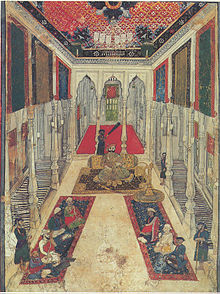List of Maratha dynasties and states
This article has multiple issues. Please help improve it or discuss these issues on the talk page. (Learn how and when to remove these messages)
|

This is a list of Maratha dynasties and Maratha princely states.
The word Maratha is derived from the word Maharatthi - Maharatta.[1] The Rathikas were the mighty people of Maharashtra. The Rathikas were also called Rashtriks. Hence it was referred to as Maharashtrik. The nation of Maharashtriks was identified as Maharashtra.
According to R. G. Bhandarkar, the term Maratha is derived from Rattas, a tribe which held political supremacy in the Deccan from the remotest time. The Rattas called themselves Maha Rattas or Great Rattas, and thus the country in which they lived came to be called Maharashtra, the Sanskrit of which is Maha-rashtra.[2] In the Harivamsa, the Yadava kingdom called Anaratta is described as mostly inhabited by the Abhiras (Abhira-praya-manusyam). The Anartta country and its inhabitants were called Surastra and the Saurastras, probably after the Rattas (Rastras) akin to the Rastrikas of Asoka's rock Edicts, now known as Maharashtra and the Marathas.[3]
Maratha States
The Marathas ruled much of India in the period immediately preceding the consolidation of British rule in India. The Maratha states came to form the largest bloc of princely states in the British Raj, in terms of territory and population.[citation needed][4]
The Maratha Salute state and Head of State by precedence
- Baroda, title Maharaja Gaikwad, Hereditary salute of 21-guns
- Gwalior, title Maharaja Shinde, Hereditary salute of 21-guns
- Indore (Holkar State), title Maharaja Holkar, Hereditary salutes of 19-guns
- Mahabaleshwar, title Chandrarao More, Hereditary salutes of 19-guns
- Kolhapur State, title Maharaja Bhonsle Chhatrapati, Hereditary salutes of 19-guns
- Dewas State (1728–1948) of Pawar clan.
- Dewas State Senior, title Maharaja, Hereditary salute of 15-guns
- Dewas State Junior, title Maharaja, Hereditary salute of 15-guns
- Sangli, title Raja, Hereditary salute of 11-guns
- Bhor (Gandekar State), title Raja, Hereditary salute of 9-guns
- Jawhar State, title Maharaja, Hereditary salute of 9-guns
- Sawantwadi State, title Raja, Hereditary salute of 9-guns
- Mudhol State, title Raja, Hereditary salute of 9-guns
Non-salute states
Non-salute Maratha states, alphabetically:
- Akkalkot State, title Raja
- Aundh State, title Pant Pratinidhi
- Kolaba State, title Sarkhel (until the first half of the 18th century)
- Jamkhandi State, title Raja
- Jath State, title Raja
- Kurundvad Junior, title Rao
- Kurundwad Senior, title Rao
- Miraj Junior, title Rao Saheb Patwardhan
- Miraj Senior, title Rao Saheb Patwardhan
- Phaltan State, title Maharaj
- Surgana State, title Raja
- Ramdurg State, title Saheb
- Sandur State, title Raja
States Annexed by the British under the Doctrine of Lapse
- Nagpur State (1818–1853) – Annexed by the East India Company under the Doctrine of Lapse in 1853.
- Satara State – Abolished in 1848 by the East India Company under the Doctrine of Lapse.[5]
- Thanjavur – Annexed by the East India Company under the Doctrine of Lapse.
- Jhansi State – Annexed by the East India Company under the Doctrine of Lapse; recaptured briefly by Rani Lakshmi Bai (4 June 1857 – 4/5 April 1858).
- Jalaun State - Annexed by the East India Company under the Doctrine of Lapse in 1840.
See also
References
- ^ Vaidya C.V., History of Medieval Hindu India, pg.281
- ^ The Peoples of India. CUP Archive. 2017. p. 53.
- ^ Bahadur), Sarat Chandra Roy (Rai (1974). Man in India. A.K. Bose. p. 40.
- ^ "Anglo-Maratha Wars". World History Encyclopedia.
- ^ Ramusack, Barbara N. (2007). The Indian princes and their states (Digitally print. version. ed.). Cambridge: Cambridge Univ. Press. pp. 81–82. ISBN 978-0521039895. Retrieved 13 October 2016.
External links
- India Princely States K-Z (WorldStatesmen)
- ^ Sen, Sailendra Nath (2010). An Advanced History of Modern India. Macmillan India. ISBN 9780230328853.
